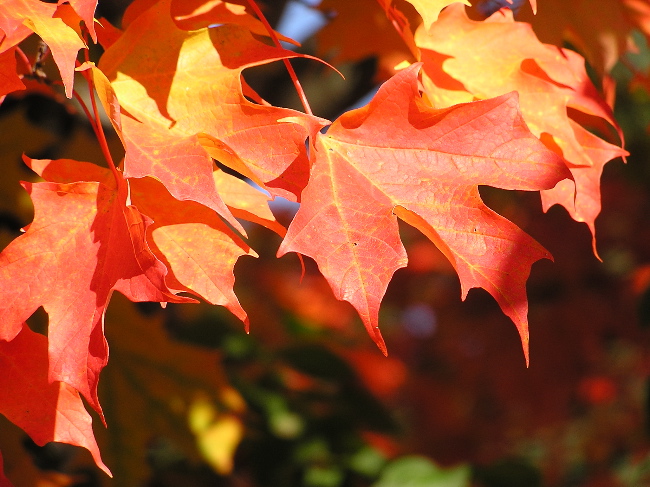This is the second half of a two part series on sugar maple. The following examines the tree’s soil and topography, cultivation, damaging agents and pests, allergenic potential, and many uses.
Introduction
Sugar maple, also called hard maple or rock maple, is one of the largest and most recognizable hardwoods in North America. It is most notable for its hardiness, vibrant fall foliage, and for being the primary source of maple syrup.
Soil & Topography
Sugar maple grows on a wide variety of soils. It may be found on sands, sandy loams, loams, and silty loams. It prefers deep, well-drained, acidic to slightly alkaline soil, with a pH ranging from 4.5 to 7.0. Sugar maple does not grow well on dry, shallow soils, and is seldom found in swamps. It rarely grows in acidic soils. Sugar maple favors moist soil conditions, but has moderate drought tolerance. Sugar maple tends to produce heavy leaf litter, which can alter the pH and nutritional quality of the soil. The pH of sugar maple leaves ranges from 4.0 to 4.9.
Sugar maple is abundant on a wide variety of soils in its northern range. Across the southern and southwestern parts of its range, sugar maple grows primarily on moist flats, and along ravines at intermediate elevations. In New Hampshire, sugar maple is associated with sites that have abundant organic matter. In West Virginia, it is most prevalent in areas teeming with oak trees. Site elevations vary. In northern New England and New York, sugar maple can grow up to 2,500 feet. In the Lake States, it is found at elevations up to 1,600 feet, mostly occurring on ridges between poorly drained areas. In the southern Appalachians, the upper elevation ranges from 3,000 feet to 5,500 feet. In the lower elevations, sugar maple is generally restricted to the cooler north slopes.
Cultivation
Sugar maple is a popular selection for cultivation. Sugar maple cultivars are available for commercial use in retail stores and nurseries across North America. Some of the most frequently selected varieties include ‘Apollo’, ‘Arrowhead’, ‘Astis’, ‘Bonfire’, ‘Caddo’, ‘Chalk Maple’, ‘Columnar’, ‘Fall Fiesta’, ‘Goldspire’, ‘Green Mountain’, ‘Inferno’, ‘Legacy’, ‘Lord Selkirk’, ‘Monumentale’, ‘Sweet Shadow’, ‘Southern’, and ‘Unity’.
Damaging Agents and Pests
Sugar maple is affected by a plethora of damaging agents and pests. The most common insects to attack sugar maple are defoliators. These include gypsy moth, forest tent caterpillar, linden looper, fall cankerworm, spring cankerworm, green-striped mapleworm, Bruce span-worm, maple leaf-cutter, maple trumpet skeletonizer, and saddled prominent. Maple phenacoccus, maple leaf scale, and gloomy scale frequently infest sugar maple. At least two species of bud miners, Proteoteras moffatiana and Obrussa ochrefasciella overwinter in the terminal bud. They cause repeated forking, which reduces log length, and increases the potential for crown loss from splitting. Forking at the terminal bud can occur in trees of all ages. Overstory trees are particularly susceptible to forking. Several other bud-damaging insects also cause crown forking. These include Choristonerua rosaceana, Cenopis pettitama, Phyllobius oblongus, and Platycerus virescens. One insect of the genus Phytobia causes minute spotting in the cambium that promotes rot. Borers that infest sugar maple include carpenterworm, sugar maple borer, maple callus borer, and horntails. Three types of aphids damage the leaves of sugar maple, hampering its growth. These include the wooly alder aphid, and the aphid species Neoprochiphilus aceris and Periphyllus lyropictus. The leaf rollers Sparganothis acerivorana and Acleris chalybeana and the maple webworm Tetralopha asperatella can cause sugar maples to rapidly decline. Severe infestations often culminate in tree mortality.
Many diseases occur on sugar maple. These diseases are seldom fatal, but can deform branches, cause widespread leaf discoloration, and reduce foliage density. The two most important diseases of sugar maple are Eutypella and Nectria cankers. Canker diseases are prevalent on sugar maple in the northern part of its range. Nectria cankers form on the branches, and trunk. The canker diseases Scizoxylon microsporum and Hypoxylon lilakei also occur on sugar maple, albeit with less frequency. Cankers generally weaken branches, rendering them prone to breakages. In rare instances, cankers may girdle and kill the tree. Common heart rots in sugar maple include Armillaria mellea, Hydnum septentrionale, Inonotus glomeratus, and Ustulina vulgaris. Armillaria mellea affects the tree’s roots. Hydnum septentrionale produces a spongy, white heart rot. Inonotus glomeratus produces a spongy, white to light brown heart rot. Ustulina vulgaris infects sugar maple sprouts, and causes flattened trunk cankers to form. Sapstreak and verticillium wilt infiltrate the tree through the roots. Cryptostroma corticale, a saprophytic fungus, sometimes develops on the bark.
Sugar maple is susceptible to physical, mechanical, and climatic injuries. Sunscald is a frequent occurrence in sugar maple stands. Trees are damaged when the trunk is exposed to rapidly fluctuating temperatures. The cells rupture, causing large vertical cracks to form. Sunscald injuries will generally heal over time. However, closure of the wound may be prolonged due to the shrinking and swelling of the trunk.
Sugar maple roots are vulnerable to road salt. When exposed to large quantities, they may be smothered, and die back. Sugar maple growth is inhibited by exposure to sulfur oxides, nitrogen oxides, chlorides, and fluorides.
Sugar maple is a vital food source for numerous animals. White-tailed deer browse on the foliage. Persistent browsing reduces growth, and can enable other trees to become dominant. Squirrels sometimes gnaw, or feed on the seeds, buds, foliage, and twigs. Porcupines are partial to the bark, and will often strip it from the tree. When heavily pecked at by sapsuckers in spring, sugar maples can develop a fungus on the sap, which causes the bark to turn black.
Allergenic Potential
Sugar maple is classified as a moderate allergen.
Uses
Sugar maple is used for a variety of purposes. It is the primary source of maple syrup. Trees are tapped in early spring for the first flow of sap, which usually has the highest sugar content. Once the sap is collected, it is boiled or evaporated into a syrup. Forty liters of maple sap are required to produce one liter of pure maple syrup. The sap is sometimes sold as a spring tonic, which may be consumed. The syrup was once used as a treatment for liver and kidney problems.
Sugar maple is commonly used as firewood. It is also frequently used in the production of saw logs, and pulpwood. Bowling alleys and bowling pins are commonly manufactured from sugar maple. The sapwood of sugar maple may sometimes appear white. When converted into small logs, white sapwood is desirable for its appearance, and texture. Sugar maple is notable for its flexible wood. This makes it a popular selection for the construction of archery bows. Sugar maple is widely used as a material in musical instruments, such as violins, guitars, and drum shells. Soap was previously made from the ashes of sugar maple. Sugar maple bark was commonly used as a dye.
Sugar maple is an important food source for wildlife. It is commonly browsed by white-tailed deer, moose, and snowshoe hare. Squirrels feed on the seeds, buds, twigs, and leaves. Porcupines feed on the bark. Sugar maple is the state tree of New York, Vermont, West Virginia, and Wisconsin. It was depicted on the state quarter of Vermont, which was issued in 2001.
Photo courtesy of Liz West/CC-by-A2.0


